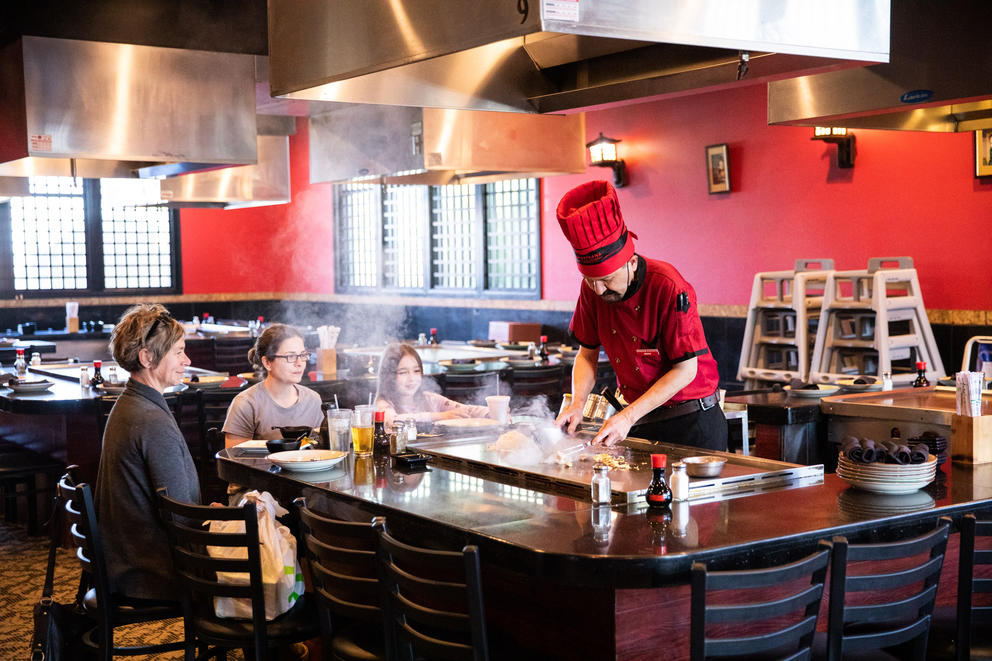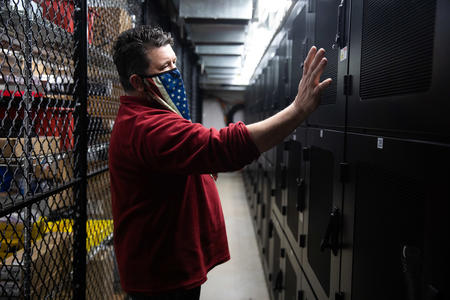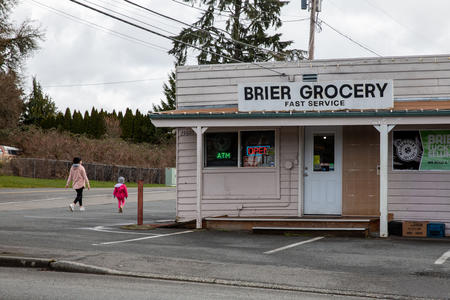They bought Tipsys in Eastern Washington as a means of income for their children. Lozano looked forward to revamping the bar, which has been around for more than 50 years. It’s a large open space with booths, two pool tables and even a jukebox.
“It used to be a super dive bar. People would shoot up in here, but I cleaned that all out,” Lozano said. “[The business], it’s a lot tougher than what I thought. We’re just making enough to pay the bills and pay the employees right now.
“We're stuck in a building that we're paying for,” Lozano added, “so we have to keep it open.”
To help shore up their finances, Gonzalez works overtime at her job in health care. Before the bar, Lozano spent 20 years selling cars, and now he plans to go back into car sales.
One of the main reasons they’ve been able to avoid closing down is because of a $11,705 federal grant. As part of the American Rescue Plan Act, the Small Business Administration awarded $918 million in Restaurant Revitalization Fund grants to more than 3,200 restaurants in Washington state last year.
Seattle-based businesses received the largest grants statewide. SBA data shows the top 23 grants — worth between $3.3 million and $10 million each — all went to businesses in the Puget Sound. Of the 145 businesses awarded more than $1 million, about 89% were located in the Seattle area.
But there wasn’t nearly enough to go around.
The funds were intended to cover expenses accrued during the pandemic, yet thousands of businesses are still drowning in debt.
Nationwide, only about a third of qualified applicants received a portion of the $28.6 billion in federal relief grant funds. Nearly 40% of that went to just 5% of applicants. Within days of the application opening last summer, business owners requested more than $72 billion — about 2½ times the amount of available funds.
The Washington Hospitality Association estimates at least 3,335 restaurants across the state shut down between January 2020 and May 2021. Association President and CEO Anthony Anton said he expects another wave of closures if these restaurants don’t get financial support. Statewide, he said, almost 4,000 businesses applied and qualified for the grant but received nothing. Many might be forced to shut down.
“They submitted, they went through the process, we know how much they qualified for,” Anton said. “Let’s fund those. That’s what I’m hoping will happen.”
This story is a part of Crosscut’s WA Recovery Watch, an investigative project tracking federal dollars in Washington state.
The SBA initially prioritized grants to self-identified restaurant owners of color, along with majority woman- and veteran-owned businesses, by giving those applicants a 21-day head start. Despite those efforts, the six largest grants in Washington were awarded to business owners in nonpriority groups. Millions more went to chains and franchises.
White male business owners in Texas and Tennesee also filed lawsuits, alleging the priority deadlines were discriminatory, later forcing the SBA to revoke thousands of previously awarded grants to priority restaurants.
“Those [priority applicants] got put back in the stack and didn’t proportionately get the same amount of money back out. It’s heartbreaking when you hear those stories,” Anton said. “I’ve talked to several of those folks who thought they were going to be OK and then had their heart broken a second time.”
There’s a sliver of hope for the future of restaurants: The Restaurant Revitalization Fund grant program could receive a new influx of money.
On April 7, the U.S. House of Representatives voted to allocate $42 billion toward replenishing the Restaurant Revitalization Fund, and it now awaits a Senate vote. If passed, it would provide funding to all original applicants from the first round, plus an additional $13 billion for struggling business. At least 90,000 restaurants and bars across the country have closed since the pandemic broke out two years ago, said the bill’s main sponsor, U.S. Rep. Earl Blumenauer, D-Oregon, and U.S. Rep. Dean Phillips, D-Minnesota.
“It would mean the world to them,” Anton said, “to see Congress step up, do the right thing and help them.”
Unbalanced awards
David Cortinas, the president of the Latin Business Association in Pasco, said he’s shocked that some businesses ended up with millions while others got pennies in comparison or nothing at all.
“They’d rather help one or two people instead of 50 people,” Cortinas said. “There wasn’t enough money for all the restaurants.”
The association did not get an email or any notification of the grant when it first opened, even though it’s a registered nonprofit with 110 members. Cortinas said he found out through another nonprofit and immediately reached out to eligible association members.
“We acted quickly to get the applications in, and we thought we would’ve been up on the top,” Cortinas said. “I know that our members were hurting, and they didn’t get anything.”
Publicly available SBA data (see table below) shows more than 28% of Washington's Restaurant Revitalization Fund awards went to Seattle-based restaurants, amounting to more than $344.8 million (37.6% of the state's total of the fund’s money).
Applicants had to self-certify whether 51% or more of their business ownership included women, veterans or socially and economically disadvantaged people, such as people of color. In Washington, data shows restaurants without any priority indicators made up almost 20% of awards, but received 28% of the money, totaling more than $253 million.
When contacted via email, SBA officials said they administered the relief program as outlined by law and conducted outreach in multiple languages. The response did not address questions about apparent disparities or efforts to change the award process if additional money gets allocated to the program.
For the businesses outside the Puget Sound area lucky enough to see any Restaurant Revitalization Fund money, it provided a lifeline while others missed out.
Tipsys was one of just eight fund recipients in Pasco. In fact, Tipsys was one of eight businesses in all of Franklin County to get the grant. (Franklin County has a population of about 98,000, with 53.6% of residents identifying as Hispanic or Latino, according to the U.S. census.) Meanwhile, in Walla Walla, a smaller county with a population of 60,000, 28 businesses received grants — more than triple what Franklin County got.
Just a three-minute walk from Tipsys sits Amor a Mexico, a restaurant dishing up everything from birra tacos to buffet-style meals inside of a 6,000-square-foot building painted a bright green, white and red — the colors of the Mexican flag.
Although one block over from Tipsys, Amor a Mexico didn’t get any federal money.
Owner Maria Mendoza said she works 13-hour days at the restaurant to keep it afloat and, at one point, she was forced to close down for six months.
She never got approved for the Paycheck Protection Program loans either, and she’s behind on her bills. The only help she has received is from the city of Pasco, which offered two $30,000 grants, one in 2020 and one in 2021. She said that without those, her restaurant wouldn’t be open today.
But she’s still struggling with debt, she said, and may have to borrow more money to boost business.
At the beginning of the pandemic she lost another business she owned, a nightclub worth $250,000, which severely impacted her finances. Pasco’s zoning and code laws have also mandated she install $90,000 fire sprinklers in order to open up additional seating and host events such as live music that could generate more business.
“I just need a little bit right now to get going. I have invested a lot of money into it. It’s the biggest restaurant in all of Tri-Cities,” Mendoza said. “I have a lot of equity in my building.”
More recently, she and some of her employees caught COVID-19 during the omicron outbreak, and the business had to shut down for part of December. With more financial help, she would get her building up to code and invest in advertising to get more customers in the door.
“Because of all the stuff going on, I stopped advertising,” Mendoza said. “I know if I go back to advertising I should start to get a lot more business, but I don’t have the funds.”
Owner Maria Mendoza serves up lunch at Amor a Mexico in Pasco on April 8, 2022. Mendoza didn’t receive any federal money or get approved for Paycheck Protection Program loans. She says she works 13-hour days at the restaurant to keep it afloat. At one point, she was forced to close down for six months. (Amanda Snyder/ Crosscut)
A lifeline for the lucky
Brenda Leon wanted to help her parents escape the labor intensive work at the orchards, so three years ago she and her husband helped them open a restaurant in East Wenatchee in Central Washington.
“It’s hard to see them go to work every single day and how that life goes so we tried to help them,” Leon said. “My husband and I thought it would be a good thing to open. That way they don’t work at the orchards — they have their own business and we can partner with them.”
Like many other businesses, the pandemic nearly forced their family-owned Mexican restaurant to shut down. But they got lucky — they received a Restaurant Revitalization Fund grant worth more than $237,000.
El Fogón was one of four restaurants in Douglas County to get a grant in the county, which has a population of 43,000.
Without the federal money, Leon said, the business would not have survived.
“We had to buy shields for the register, keeping people here employed. We had a few people who got COVID, so we paid them for time off,” she said. “Buying the materials to keep our business running, like the shields, sanitizers. It doesn’t seem like it costs much, but it all adds up.”
They are struggling to hire people right now, and Leon and her mother are the only cooks.
“We have been short-staffed at some points because they were getting sick, so we’re trying to fill up those spots and then we lost a few employees, and it’s been hard to hire people because we don’t have applicants,” Leon said. “We’ve had hiring signs up for about eight months.”
Fujiyama, a family-friendly restaurant that cooks Japanese food hibachi-style in front of customers, has four locations throughout the state. Two locations received Restaurant Revitalization Fund grants, one in Liberty Lake near Spokane and one in Richland, for a combined $800,000.
Co-owner Ken Hwang said Fujiyama also had savings and Payroll Protection Program loans to help weather the pandemic. The restaurant’s businesses could have survived without the revitalization fund money, but it would have cut it close.
Fujiyama permanently closed its Pullman location after Washington State University halted all in-person learning and activities in March 2020.
“Sales went down. We were really suffering, so of course we had to lay off a lot of employees, but we were able to keep some employees with PPP loans, and we still made our best efforts to try to keep as many employees as possible,” Hwang said. “After that fund was provided, there was enough cash to bring everybody back.”
Hwang said that while all the partners have a family connection, each Fujiyama has its own limited liability company, and each is treated as a separate entity. As a result, each location and its partners could submit a Restaurant Revitalization Fund application. This is similar to how larger chains and franchises are independent and separately owned, so each location was able to apply; however most are not tied by family like Fujiyama.
Businesses with more than 20 locations were not eligible for a revitalization fund grant, but many chain restaurants, franchises and other large businesses with multiple locations were awarded millions in grant money from the fund in Washington.
For instance, almost all IHOP locations received grants, for a combined total of $8.3 million. The program awarded relief money to 29 of the 32 total IHOP locations listed in the state, and 80 different Subways each got a grant as well.
Of all grants given outside of the Puget Sound area, the largest was awarded to a Golden Corral franchise location in Vancouver. Co-owner Ramsey Zawideh, who identified as socially or economically disadvantaged, received $2.8 million. It’s one of about 500 Golden Corrals throughout the country. It was also one of the few restaurants owned by a person of color outside the Puget Sound area to receive a grant among the state's 100 largest awards.
Zawideh said the restaurant would have gone under without the grant, especially since it had to close down for six months starting in March 2020 and operated at less than half capacity for the remainder of the year. Franchise fees range anywhere from 4% to 12%, depending on a variety of factors, he said, but he feels lucky because Golden Corral’s corporate operation suspended franchise fees for nearly a year.
“A lot of other franchises did not do that,” he noted.
Still in need of relief
Anton, with the Washington Hospitality Association, said he remains concerned about the immediate future. If a second restaurant relief package doesn’t pass, he expects devastating consequences.
“Those who did not receive Restaurant Revitalization Funds built up a tremendous amount of debt,” Anton said. “They don’t make enough per year to pay off that debt, so it will take several years to dig out of this. And how long will the people that they owe that money to be patient with them before it forces the small business to close?”
In the city of Walla Walla, family-owned Modern Chinese Restaurant got a grant relief check worth $13,407, which primarily went toward COVID supplies and employee paychecks.
Chi Chen, 19, manages the restaurant for his parents, and he said it likely would have survived without this grant, but it would have been much harder, as they never received any other grants from the state, making this grant their only assistance.
The restaurant has been here since 1965, and many of their customers have been coming for decades. His parents took over the business about 10 years ago.
“Most customers are elderly people, like seniors,” Chen said. “They always say how they’ve been here since the 1970s, the ’80s, since they were a kid.”
Chi estimated that the restaurant is now operating at 70% capacity, and still not profiting as it was before the pandemic.
Anton said that although the future of the hospitality industry looks hopeful in terms of the increasing public interest in dine-in, he fears that the short term will result in more closures. It’s possible that new businesses might come into the picture, while their neighbors’ dreams die amid the pandemic.
More debt relief, he said, especially to those who missed out the first time, could help thousands of these existing businesses survive.
“It would allow them to start moving forward,” Anton said. “It would be an enormous relief and probably save the industry from another round of closures, it’s probably imminent, because not everyone is going to be able to catch up to that debt.”
Many small family-owned restaurants are just barely hanging on, bogged down with crippling debt. Without outside support, it’s unclear what the future holds.
Cortinas, with the Latin Business Association, said he notified several businesses of the initial restaurant grants, including Amor a Mexico. None of them received anything.
With restaurants still reeling from two recent variant surges of COVID and an uncertain end to the pandemic, Cortinas said he worries about what will happen to these businesses left behind by relief programs.
“It’s like a piranha fish going after a piece of meat — everybody wants it,” Cortinas said. “That’s the way we treat grants. It’s free money. It’s always the big boys who get the money, not the small boys. I just can’t believe somebody gets $2 million while others get nothing.”
Correction: David Cortinas is the president of the Latin Business Association in Pasco. A previous version of this story incorrectly identified him as leading a different local business organization.













